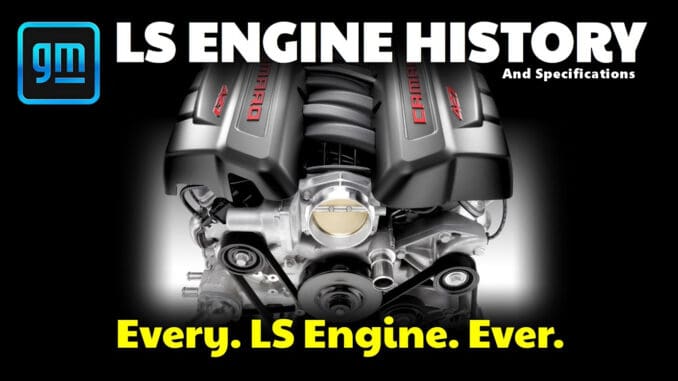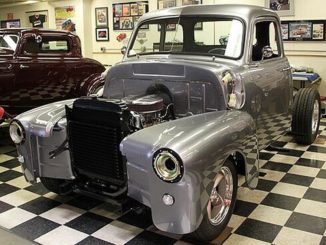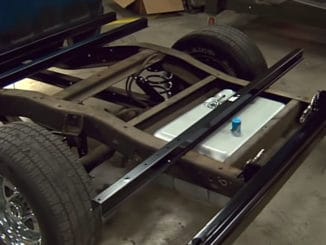
The LS based small-block engine is the primary V-8 used in General Motors’ line of rear-wheel-drive cars and trucks. Introduced in January 1995, it is a “clean sheet” design with only rod bearings, lifters, and bore spacing in common with the longstanding Chevrolet small-block V-8 that preceded it as the basis for GM small-block V-8s.
The LS small-block has been manufactured in three Generations – III, IV, and V – with preceding Generations I and II of modular GM small-block engines having been based on the Chevrolet small-block V-8 originally released in 1954. GM recycled the “LT” designation beginning with the LS Generation V “LT1” in 2014.
Several versions of the LS were used in the Chevrolet Corvette, beginning with the LS1 in 1997 through the LS9 and others in 2013. Variants of the LT version of the GM small block have been used since.
The basic LS variations use cast iron blocks, while performance editions are all aluminum with cast iron cylinder liners.
Performance Improvements Over Classic Small Block Engine
The performance improvements in the LS-family V-8s over the previous classic small-block V-8 family are several. The lower section of the block incorporates deep side skirts, along with 6-bolt cross-bolted main bearing caps. This fully boxes the crankshaft, creating an extraordinarily strong and rigid structure that has been hot-rodded by enthusiasts to over 1,000-HP.
Although it is the same compact physical size as the classic small-block V-8, this block can accept a 4-inch stroke as an option in its stock form, due to the cam location being elevated slightly, compared to previous block designs.
Also, the cam bearing journals are larger, to allow for a higher cam-lift profile than was previously possible. The stock aluminum heads can provide a high amount of airflow, which previously could only be found in aftermarket race-performance heads.
The aluminum heads also incorporate steam vents to prevent gas pockets from building up in critical areas, and this is vital in allowing the coolant to manage heat build-up for high-performance applications. Such design features allow for a higher compression ratio with no fear of detonation.
The thermostat has been located at a low position, which eliminates the possibility of a gas pocket preventing the thermostat from properly sensing the heat of the coolant.
Previous generations incorporated a coolant passage through the intake manifold to warm the incoming fuel-air mixture in very cold climates. However, modern fuel-injection techniques eliminate fuel atomization concerns under all conditions, so the LS family uses a dry intake manifold. This removes a common coolant leakage point and allows the incoming air to remain as cool as possible for better power production.
LS Engine VIN Codes and Specifications below video…
LS Engine VIN Codes and Specifications
The 8th character in the VIN or the RPO code from the glove box sticker can be used to identify which type of LS engine a vehicle has.
Editor’s Note: Engine RPO Codes and Engine Sizes in the table below are linked to donor vehicle Make/Model listing and donor engines for sale (if any listings available). Due to the amount of information presented, the table below scrolls horizontally.
| Gen | Years | Engine Code & VIN | Horsepower | Torque (lb-ft) | Size (Liters) | Fuel Type (E85/89/91/93) | Bore (inches) | Stroke (inches) | Compression Ratio | Block & Heads | Block Features |
|---|---|---|---|---|---|---|---|---|---|---|---|
| III | 1997-05 | LS1 (G) | 305-350 @ 5600 | 350-365 @ 4400 | 5.7 | 91 | 3.90 | 3.62 | 10.25:1 | Aluminum | |
| III | 2001-05 | LS6 (S) | 385-405 @ 6000 | 385-400 @ 4800 | 5.7 | 3.90 | 3.62 | 10.5:1 | Aluminum | ||
| III | 1999-07 | LR4 (V) | 255-285 | 285-295 | 4.8 | 3.78 | 3.3 | 9.45:1 | Iron/Aluminum Heads | ||
| III | 1999-07 | LM7 (T) | 270-295 | 315-335 | 5.3 | 3.78 | 3.62 | 9.49:1 | Iron/Aluminum Heads | ||
| III | 2002-07 | L59 (Z) | 285-295 | 320-335 | 5.3 | E85-capable | 3.78 | 3.62 | 9.9:1 | Iron/Aluminum Heads | |
| III | 2003-04 | LM4 (P) | 290 | 325 | 5.3 | 3.78 | 3.62 | 10.0:1 | Aluminum | ||
| III | 2005-08 | L33 (B) | 310 @ 5200 | 335 @ 4400 | 5.3 | 3.78 | 3.62 | 10.0:1 | Aluminum | ||
| III | 1999-08 | LQ4 (U) | 300-325 @ 5200 | 360-370 @ 4400 | 6.0 | 4.00 | 3.62 | 9.4:1 | Iron/Iron-Aluminum Heads | ||
| III | 2002-07 | LQ9 (N) | 345 @ 5200 | 380 @ 4000 | 6.0 | 4.00 | 3.62 | 10.0:1 | Iron/Aluminum Heads | ||
| IV | 2008-17 | LS3 (W) | 426-436 @ 5900 | 420-428 @ 4600 | 6.2 | 93rec | 4.06 | 3.62 | 10.7:1 | Aluminum/Aluminum Heads | Sodium Exhaust Valves |
| IV | 2010-15 | L99 (J) | 400 @ 5900 | 410 @ 4300 | 6.2 | E85-capable | 4.06 | 3.62 | 10.4:1 | Aluminum/Aluminum Heads | AFM, VVT, |
| IV | 2009-15 | LSA (P) | 556-580 @ 6100 | 551-556 @ 3800 | 6.2 | 93req | 4.06 | 3.62 | 9.1:1 | Aluminum/Aluminum Heads | 1.9L Supercharger |
| IV | 2010-12 | L94 (F) | 403 @ 5700 | 417 @ 4300 | 6.2 | E85-capable | 4.06 | 3.62 | 10.4:1 | Aluminum/Aluminum Heads | AFM, VVT |
| IV | 2007-09 | L76 (Y) | 361-367 @ 5600 | 375-385 @ 4400 | 6.0 | 4.00 | 3.62 | 10.4:1 | Aluminum | AFM | |
| IV | 2011-16 | L77 (2) | 362 @ 5700 | 391 @ 4400 | 6.0 | E85-capable | 4.00 | 3.62 | 10.4:1 | Aluminum | AFM |
| IV | 2010-17 | L96 (G) | 322-360 @ 4400-5400 | 373-382 @ 4200-4400 | 6.0 | E85-capable | 4.00 | 3.62 | 9.7:1 | Iron/Aluminum Heads | VVT |
| IV | 2009-10 | L98 (H) | 362 @ 5700 | 391 @ 4400 | 6.0 | 4.00 | 3.62 | 10.4:1 | Aluminum | L76 with AFM hardware removed. | |
| IV | 2007-09 | LY2 (C) | 260-295 | 295-305 | 4.8 | 3.78 | 3.3 | 9.08:1 | Iron/Aluminum Heads | no VVT | |
| IV | 2010-12 | L20 (A) | 260-302 @ 5400 | 295-305 @ 4600 | 4.8 | E85-capable | 3.78 | 3.3 | 8.8:1 | Iron/Aluminum Heads | no AFM, VVT |
| IV | 2005-09 | LH6 (M) | 300-315 | 330-338 | 5.3 | 3.78 | 3.62 | 9.95:1 | Aluminum | AFM, VVT* | |
| IV | 2007-09 | LY5 (J) | 315-320 @ 5200 | 335-340 @ 4000 | 5.3 | 3.78 | 3.62 | 9.95:1 | Iron/Aluminum Heads | AFM, VVT* | |
| IV | 2008-12 | LMG (0) | 315-320 @ 5200 | 335-340 @ 4000 | 5.3 | E85-capable | 3.78 | 3.62 | 9.6:1 | Iron/Aluminum Heads | AFM, VVT* |
| IV | 2007-12 | LC9 (3) or (7) | 315-320 @ 5400 | 335 @ 4000 | 5.3 | E85-capable | 3.78 | 3.62 | 9.95:1 | Aluminum | AFM, VVT* |
| IV | 2005-09 | LS4 (C) | 303 @ 5600 | 323 @ 4400 | 5.3 | 3.78 | 3.62 | 10.0:1 | Aluminum | AFM, FWD | |
| IV | 2008-09 | LH8 (L) | 300 @ 5200 | 320 @ 4000 | 5.3 | 3.78 | 3.62 | Aluminum | |||
| IV | 2007-08 | L92 (8) | 403 | 415 | 6.2 | 4.06 | 3.62 | 10.5:1 | Aluminum | VVT | |
| IV | 2009-12 | L9H (2) | 403 | 415 | 6.2 | E85-capable* | 4.06 | 3.62 | 10.5:1 | Aluminum | VVT |
| IV | 2005–07,09 | LS2 (U) | 390-400 @ 6000 | 400 @ 4400 | 6.0 | 93 | 4.00 | 3.62 | 10.9:1 | Aluminum | |
| IV | 2007-10 | LY6 (K) | 361 @ 5600 | 385 @ 4400 | 6.0 | 4.00 | 3.62 | 9.67:1 | Iron/Aluminum Heads | VVT | |
| IV | 2008-09 | LFA (5) | 332 @ 5100 | 367 @ 4100 | 6.0 | Hybrid | 4.00 | 3.62 | 10.8:1 | Aluminum | AFM |
| IV | 2010-12 | LZ1 (J) | 332 @ 5100 | 367 @ 4100 | 6.0 | Hybrid | 4.00 | 3.62 | 10.8:1 | Aluminum | AFM | VVT |
| IV | 2009-13 | LS9 (R/T) | 638 @ 6500 | 604 @ 3800 | 6.2 | 92 | 4.065 | 3.62 | 9.1:1 | Aluminum/Aluminum Heads | 2.3L Supercharger | Titanium Connecting Rods | Forged Pistons | Dry Sump |
| IV | 2006-15 | LS7 (E) | 505 @ 6300 | 470 @ 4800 | 7.0 | 91 | 4.125 | 4.00 | 11.0:1 | Aluminum | Titanium Connecting Rods | Dry Sump |
| IV/V | none | LSX376 | 450 @ 5900 | 444 @ 4600 | 6.2 | 92 | 4.06 | 3.62 | 9:1 | Aftermarket | |
| IV/V | none | LSX454 | 620 @ 6200 | 590 @ 4800 | 7.4 | 92 | 4.185 | 4.125 | 11.0:1 | Aftermarket | |
| IV/V | none | LSX454R | 776 @ 7000 | 680 @ 4500 | 7.4 | 110 | 4.185 | 4.125 | 13.1:1 | Aftermarket | |
| V | 2014–present | LT1 | 455-460 @ 6000 | 460-465 @ 4600 | 6.2 | 93rec | 4.06 | 3.62 | 11.5:1 | Aluminum/Aluminum Heads | VVT | DI | Dry Sump (Corvette) | AFM |
| V | 2020–present | LT2 | 490-495 @ 6450 | 465-470 @ 5150 | 6.2 | 4.06 | 3.62 | 11.5:1 | Aluminum/Aluminum Heads | VVT | DI | Dry Sump | AFM | |
| V | 2015–present | LT4 | 640-650 @ 6400 | 630-650 @ 3600 | 6.2 | 4.06 | 3.62 | 10:1 | Aluminum/Aluminum Heads | VVT | DI | 1.7L Supercharger | Dry Sump(Corvette) | AFM | |
| V | 2018–present | LT5 | 755 @ 6400 | 715 @ 3600 | 6.2 | 4.06 | 3.62 | 10:1 | Aluminum/Aluminum Heads | VVT | Hybrid Port/Direct Injection | 2.6L Supercharger | Dry Sump | |
| V | 2014–present | L83 (C) | 355-376 @ 5600 | 383-416 @ 4100 | 5.3 | E85-capable | 3.78 | 3.62 | 11.0:1 | Aluminum/Aluminum Heads | VVT | DI | AFM |
| V | 2014–present | L86 (J) | 420 @ 5600 | 460 @ 4100 | 6.2 | NOT E85-capable | 4.06 | 3.62 | 11.5:1 | Aluminum/Aluminum Heads | VVT | DI | AFM |
| V | 2020– | L8T | 401 @ 5200 | 464 @ 4000 | 6.6 | 87 | 4.06 | 3.85 | 10.5:1 | Iron/Aluminum Heads | VVT | DI |
| Gen | Years | Engine Code & VIN | Horsepower | Torque (lb-ft) | Size (Liters) | Fuel Type (E85/89/91/93) | Bore (inches) | Stroke (inches) | Compression Ratio | Block & Heads | Block Features |
Acronyms:
- AFM - Active Fuel Management/Advanced Fuel Management
- DI - Direct Injection
- RPO - Regular Production Option
- VIN- Vehicle Identification Number
- VVT - Variable Valve Timing/Variable Valve Train
Note 1: Depending upon vehicle application (truck, SUV, passenger car); horsepower, torque, and fuel requirements will vary. VIN code indicating engine RPO is usually not consistent between vehicle types (cars or trucks) or years. with few exceptions, the RPM redline is generally 6000 or higher.
Note 2: Block features are generally dependent upon the Generation but are not always built-in. Typical features are AFM (Advanced Fuel Management), VVT (Variable Valve Train), Front Wheel Drive (FWD), and other improvements. Features marked with an * indicate that only certain model years have that feature.
History of the GM LS Engine Family
Most of the credit for the LS engine family must go to Ed Koerner, GM’s Powertrain vice president of engineering operations at the time. He was a V-8 design veteran and former National Hot Rod Association (NHRA) record holder in drag racing.
Koerner had been the Chief Engineer for all the existing GM small-block V-8 engines and was put in charge of the “all-new” Gen III LS1 V-8 development project, which would share no parts with previous engines.
This video from Auto Guild details every LS engine, in order of release from the LS1 launch in 1997 to the awesome LS9 in 2009, to the last of the Gen IV LS engines in 2017 — Each engine is detailed including horsepower, compression rations, bore and stroke, cylinder head type, and which models had which engines for each year…




